— Compiled and written by Paul C. Focazio, New York Sea Grant
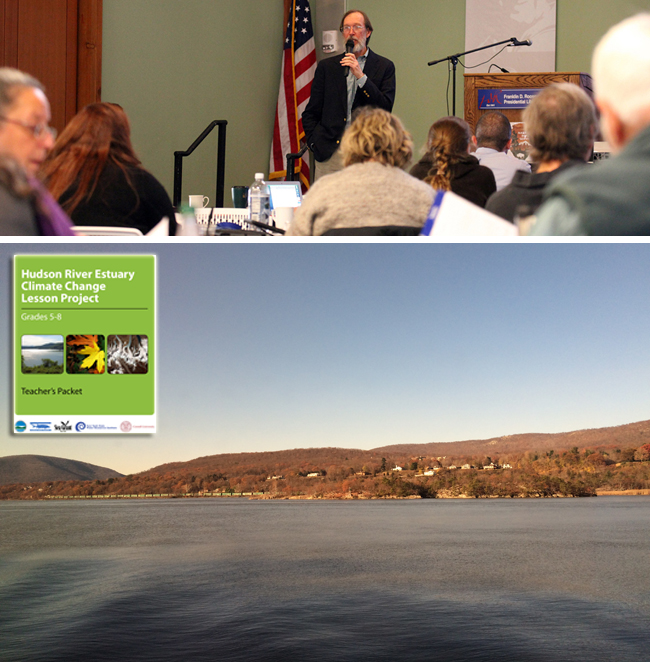
New York Sea Grant partnered with the NYSDEC's Hudson River Estuary Program and Teaching the Hudson Valley for a mid-November workshop with experts and educators who explored climate change and its impacts in the Hudson Valley. The all-day event, held at the FDR Home & Presidential Library and Museum's Henry A. Wallace Visitor and Education Center in Hyde Park, NY, featured field- and classroom-tested ways to cover the topic in a teacher's curriculum and programs. Photo Credit (for this and other photos on this page): Bill Urbin, Roosevelt-Vanderbilt-Van Buren National Historic Sites, National Park Service / Paul C. Focazio, New York Sea Grant
Hyde Park, NY, December 14, 2014 - Whether observing local climate changes from the classroom, looking at pollen to learn about the Hudson Valley’s ancient climate or examining satellite photos of Earth from space, each of the lesson plans in a new series from New York Sea Grant provides ways teachers can engage their students.
These Climate Change Lesson Plans—which were unveiled at a "Covering Climate Change in the Classroom" workshop for educators at the Franklin D. Roosevelt Presidential Library and Museum in Hyde Park, NY last month—are designed to help middle school students understand climate and weather basics and explore climate change related issues close to home in the Hudson River Valley.
Lessons that include an energy walkabout or an oral history of climate change bring in valuable social science components. All the lessons provide teachers with tools to evaluate student work as well as a matrix to show how the content fits into Learning Standards for New York State, Next Generation Learning Standards and the Common Core.
Produced in partnership with the New York State Water Resources Institute (NYS WRI) at Cornell University and the New York State Department of Environmental Conservation's Hudson River Estuary Program (NYSDEC HREP) with support through the New York State Environmental Protection Fund, most of the educational materials in this NYSG series have been adapted for use from existing peer-reviewed lesson plans. The original source material is credited at the beginning of each lesson, which may be used independently as the series was not designed as a sequential curriculum unit.
"Working with these partner organizations, we’ve selected some of the best peer-reviewed lessons and adapted them for use along the Hudson," said Nordica Holochuck, NYSG's Hudson Estuary Specialist. "There are many resources for that teachers can draw from to integrate Climate Change education in classrooms. These plans will be particularly useful for teachers in coastal communities along the Hudson River."
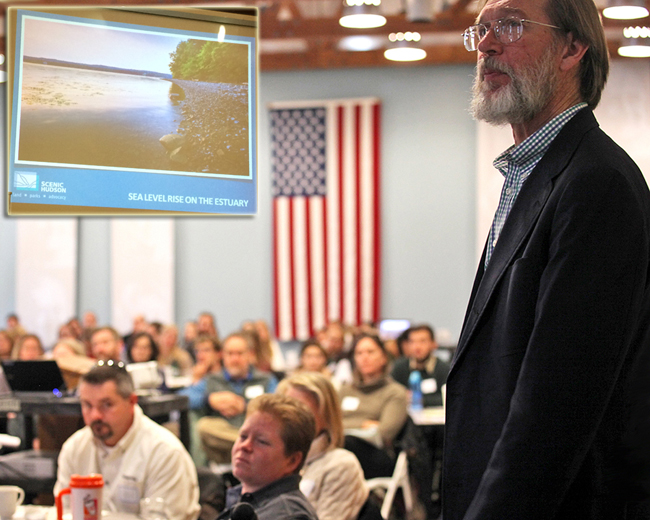
"The goal of projects such as this one is to foster place-based teaching about the Hudson and to fulfill the goals of the Hudson River Estuary Action Plan in promoting conservation and public understanding and enjoyment of the river,” said NYSDEC HREP Estuary Education Coordinator Steve Stanne (pictured above, at far right), who helped to select, review and edit the lesson plans in this series. This project was also completed thanks to Meghan E. Marrero, Ed.D., Associate Professor of Secondary Education at Mercy College and to Mr. Seth Van Gaasbeek, both educators in New York's Hudson Valley region who spent many hours editing and reviewing the plans and correlating them to learning standards.
These materials are the latest edition to the Estuary program's educational resources. Additional Hudson River lessons can be found on the Hudson Estuary Program’s Web site.
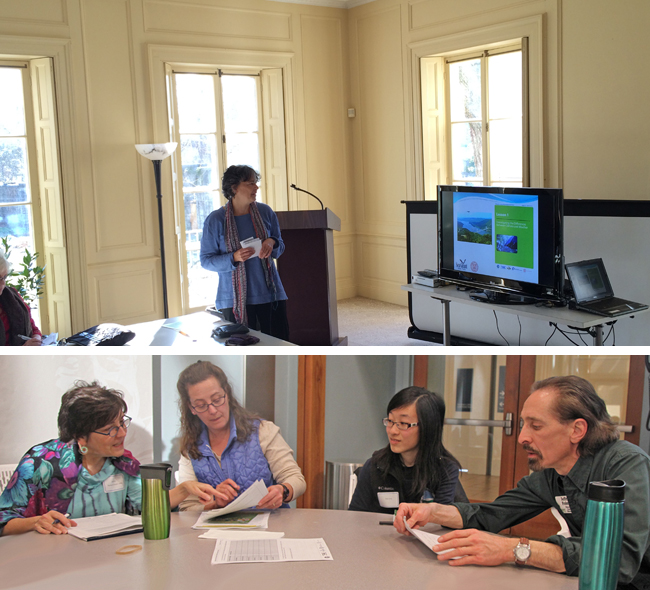
One of the two lesson plans that NYSG's Hudson Estuary Specialist Nordica Holochuck (pictured in top photo above) debuted at mid-November's workshop for educators about climate change and its impacts zeroed in on investigating the difference between climate and weather. During the session, Holochuck showed the educators how to interpret local weather data with their students. There was also a a hands-on matching activity designed to help young students explore climate and weather. "Understanding the relationship between weather and climate are important first steps to understanding larger-scale global climate change," she said.
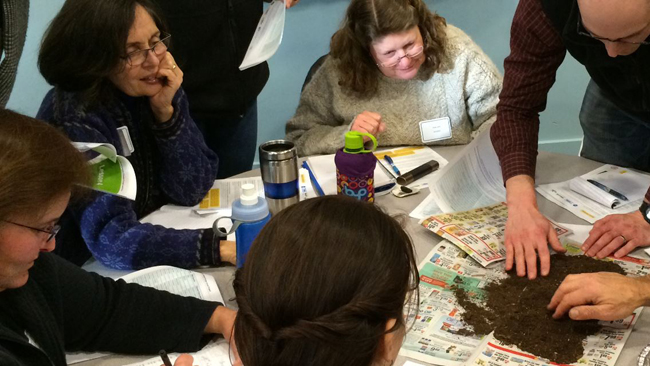
Another of the new lesson plans, Paleoclimate on the Hudson Valley, was also put to the test with the teachers in attendance. "Students can learn about climate history and its connections to climate change through a simple activity that introduces them to how scientists study sediment cores to find out what the climate was like here in the past," said Holochuck.
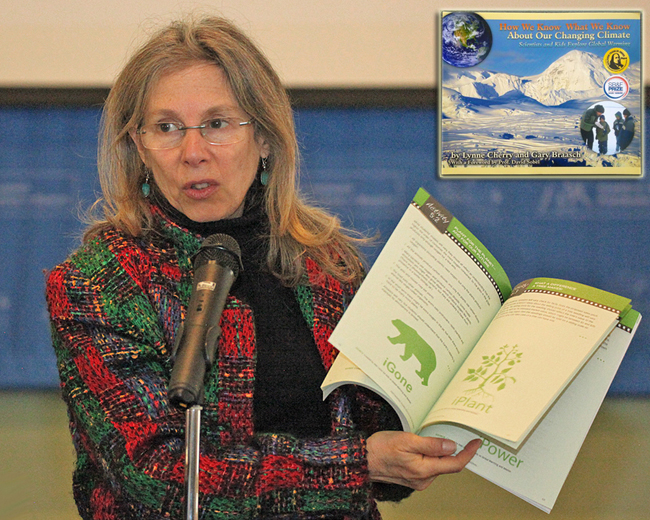
The workshop's keynote, author and film maker Lynne Cherry,
spoke on the psychology of teaching about climate change, touching upon
the challenges of teaching about the topic in ways that inspire people
to engage and act. During her talk, Lynne cited the value of the written
word, like her essay "How to Teach Your Children About Climate Change: Without Scaring Them," which she coauthored with Gary Braasch. She and Gary are also the co-authors of the award-winning book How We Know What We Know About Our Changing Climate.
After addressing the educators, Cherry screened her short documentary
film "We Sing Out!" which features the Rivertown Kids chorus (based in
Beacon, New York) singing with the late folk singer Pete Seeger about
their vision of a sustainable world. "As political leaders and
policymakers around the world grapple with the severe impacts of global
warming," she said, "my hope is that by championing youth solutions to
climate change, young people and adults will be inspired to fight global
warming in their own towns and cities, thus helping change the course
of this looming crisis."
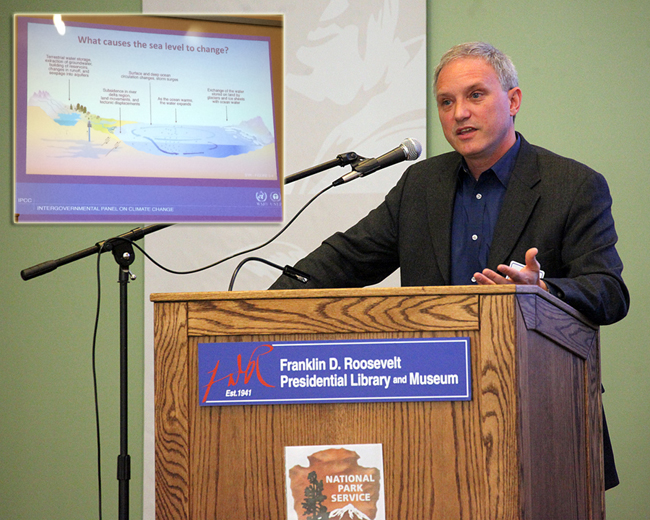
Hudson River Estuary Program Habitat Restoration Coordinator Dan Miller explored what recent extreme weather events—Hurricanes and Superstorms like Sandy, Irene and Lee—tell us about the Hudson River’s resiliency. "Climate models predict that our region will experience increased precipitation in more episodic and intense events," he said. "Irene, Lee, and Sandy have given us a taste of what that might mean for the Hudson," citing the latter two in particular had acute short-term effects on water quality and fish communities. Recovery from more long-term impacts to the River's submerged aquatic vegetation, though, continue. Although there will surely be more storms like these, Miller said restoration efforts can enhance ecosystem resiliency and recovery from future large storms.
During his presentation, Miller featured graphics from the Climate Central Web site to emphasize how accelerated ice loss in both Greenland and Alaska have contributed to many a climate change discussion.
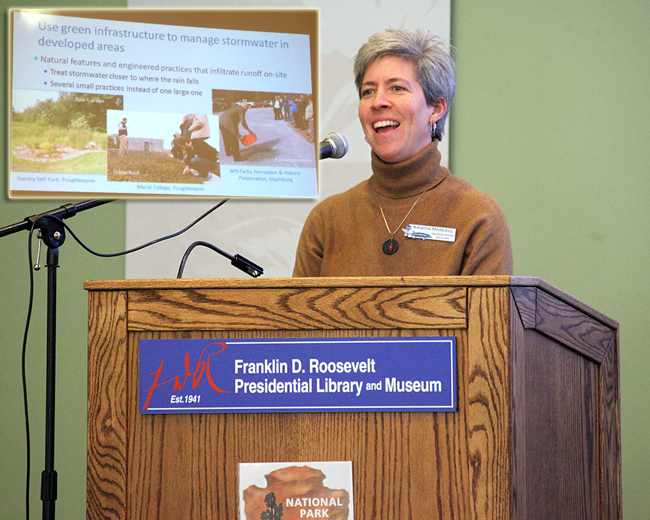
Kristin Marcell, Special Projects Coordinator for the NYS DEC Hudson River Estuary Program/Cornell University, discussed how communities are taking action to adapt to changing conditions, like flooding. She also highlighted the State’s new program, Climate Smart Communities, which is designed to help communities reduce emissions, save money, and reduce their vulnerability to extreme weather.
More Info:
New York Sea Grant (NYSG), a cooperative program of Cornell University
and the State University of New York, is one of 33 university-based
programs under the National Sea Grant College Program (NSGCP) of the
National Oceanic and Atmospheric Administration (NOAA). The NSGCP
engages this network of the nation’s top universities in conducting
scientific research, education, training and extension projects designed
to foster science-based decisions about the use and conservation of our
aquatic resources. Through its statewide network of integrated
services, NYSG has been promoting coastal vitality, environmental
sustainability, and citizen awareness about the State’s marine and Great
Lakes resources since 1971.
For updates on Sea Grant activities:
www.nyseagrant.org has RSS,
Facebook,
Twitter, and
YouTube links. NYSG also offers a free e-list sign up via
www.nyseagrant.org/coastlines for
NY Coastlines, its flagship publication, which merged with our e-newsletter,
Currents, in 2014 - is published several times a year.